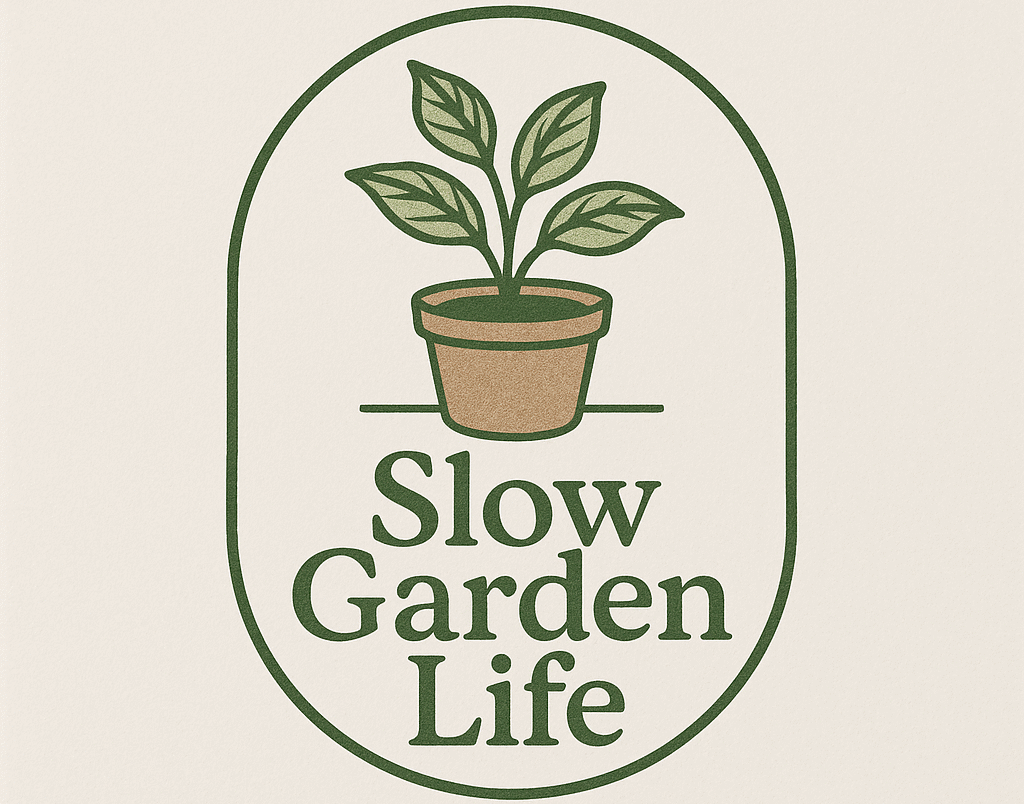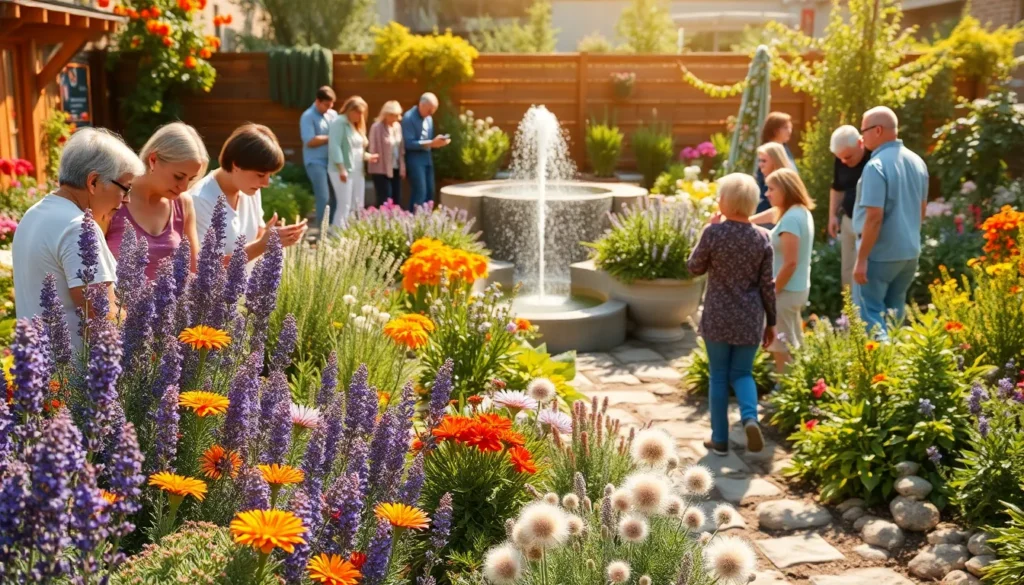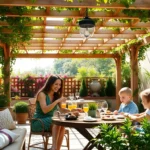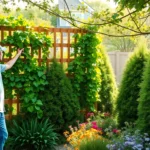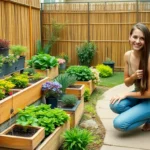We’ve all experienced that magical moment when a garden captivates every one of our senses – the gentle rustle of ornamental grasses, the intoxicating fragrance of blooming jasmine, or the satisfying crunch of gravel beneath our feet. Creating a sensory garden transforms any outdoor space into an immersive sanctuary that engages sight, sound, smell, touch, and even taste in extraordinary ways.
Whether you’re designing a therapeutic retreat for relaxation or an educational space that delights children and adults alike, sensory gardens offer endless possibilities for creativity and wellness. These thoughtfully curated spaces don’t require vast acreage or expensive installations – even small balconies and tiny yards can become sensory wonderlands with the right plant selections and design elements.
We’re about to explore dozens of innovative ideas that’ll help you create a garden experience that awakens your senses and soothes your soul. From aromatic herb spirals to textured pathway materials, these practical concepts will transform your outdoor space into a multi-sensory oasis.
Create a Fragrant Herb Garden Section
Herbs transform sensory gardens into aromatic sanctuaries that delight both nose and palate. We’ll explore how strategic herb placement creates layers of fragrance that change throughout the day and seasons.
Plant Aromatic Herbs Like Lavender and Rosemary
Lavender serves as the cornerstone of fragrant herb gardens with its distinctive purple spikes releasing calming essential oils. We recommend planting English lavender varieties like ‘Hidcote’ or ‘Munstead’ in sunny, well-drained locations where visitors can brush against the stems to release maximum fragrance.
Rosemary adds woody, pine-like aromas that intensify in warm weather and complement lavender’s floral notes perfectly. Mediterranean varieties such as ‘Tuscan Blue’ and ‘Miss Jessop’s Upright’ create year-round structure while providing continuous fragrance when touched or walked past.
Position these aromatic powerhouses along pathways where foot traffic naturally occurs. Strategic placement ensures every garden visitor experiences their signature scents without requiring deliberate interaction.
Add Mint and Basil for Kitchen Garden Appeal
Mint varieties offer instant gratification with their cooling, invigorating scents that release immediately upon contact. We suggest planting spearmint, peppermint, and chocolate mint in contained areas since these vigorous spreaders can quickly overtake garden beds.
Basil provides sweet, spicy fragrances that vary dramatically between cultivars like cinnamon basil, lemon basil, and traditional sweet basil. Fresh basil leaves release their essential oils when gently rubbed between fingers, creating an interactive sensory experience.
Container planting works exceptionally well for both herbs, allowing us to control their growth while positioning them at perfect nose height for maximum impact. Raised planters or decorative pots also make harvesting easier for culinary use.
Include Scented Geraniums for Unique Fragrances
Scented geraniums surprise visitors with unexpected aromas ranging from rose and lemon to nutmeg and chocolate. These versatile plants require minimal maintenance while providing months of continuous fragrance through their textured, aromatic foliage.
Varieties like ‘Attar of Roses’ and ‘Lady Plymouth’ offer complex scent profiles that change intensity throughout the day. We position these plants where afternoon sun can warm their leaves, intensifying their natural perfumes.
Interactive placement near seating areas or along garden borders encourages visitors to touch and smell different varieties. Grouping multiple scented geranium types creates a natural perfume library that engages curiosity and provides educational opportunities about plant aromatics.
Design Interactive Touch and Texture Zones
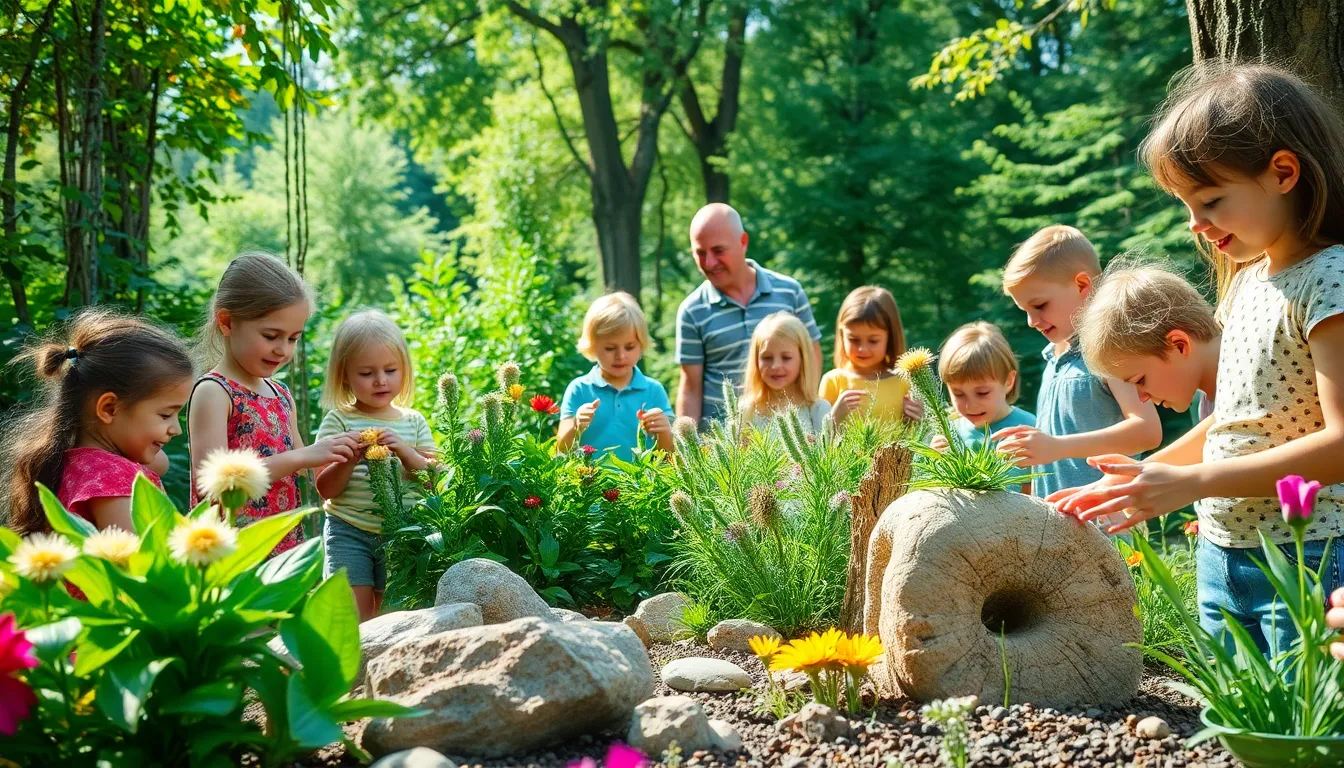
We’ll transform your sensory garden into a tactile playground by creating distinct zones that invite visitors to explore through touch. These interactive areas complement the aromatic herbs we’ve already established while adding captivating textural elements.
Incorporate Soft Lamb’s Ear and Fuzzy Plants
Lamb’s Ear stands out as our top choice for fuzzy textures with its incredibly soft, velvety leaves that feel like touching fabric. We recommend planting these silver-green perennials along garden borders where visitors can easily reach and stroke their distinctive foliage.
Velvety rose petals provide another layer of soft texture while adding visual beauty to your sensory zones. Choose varieties like ‘Mr. Lincoln’ or ‘Double Delight’ that produce large, touchable blooms throughout the growing season.
Fuzzy mullein creates dramatic vertical interest with its towering flower spikes and woolly leaves that children and adults love to pet. We suggest positioning these biennial plants as focal points where their impressive height and texture can be fully appreciated.
Add Smooth River Rocks and Rough Tree Bark
Smooth river rocks create natural pathways that provide cool, polished surfaces under bare feet or fingertips. We place these stones strategically along walkways and around plant beds to offer contrasting textures between soft vegetation and hard surfaces.
Rough tree bark introduces coarse textures that stimulate different nerve endings than smoother materials. Oak, pine, and maple trees with deeply grooved bark work exceptionally well as natural textural elements in larger sensory gardens.
Driftwood pieces scattered throughout garden beds offer weathered, smooth-rough combinations that tell stories of natural weathering processes. These elements bridge the gap between completely smooth and entirely rough textures.
Install Tactile Sculptures and Garden Art
Interactive sculptures made from natural materials like carved wood and textured stone invite hands-on exploration while serving as artistic focal points. We choose pieces with varying surface treatments from polished sections to rough-hewn areas.
Garden art incorporating different materials creates texture stations where visitors can compare surfaces like smooth ceramic, rough concrete, and brushed metal all in one installation. These multi-textural pieces maximize sensory engagement in minimal space.
Natural element sculptures using materials like bamboo, gourds, and river stones provide organic textures that change with weather and seasons. We position these pieces at child-friendly heights to encourage interaction from visitors of all ages.
Install Water Features for Soothing Sounds
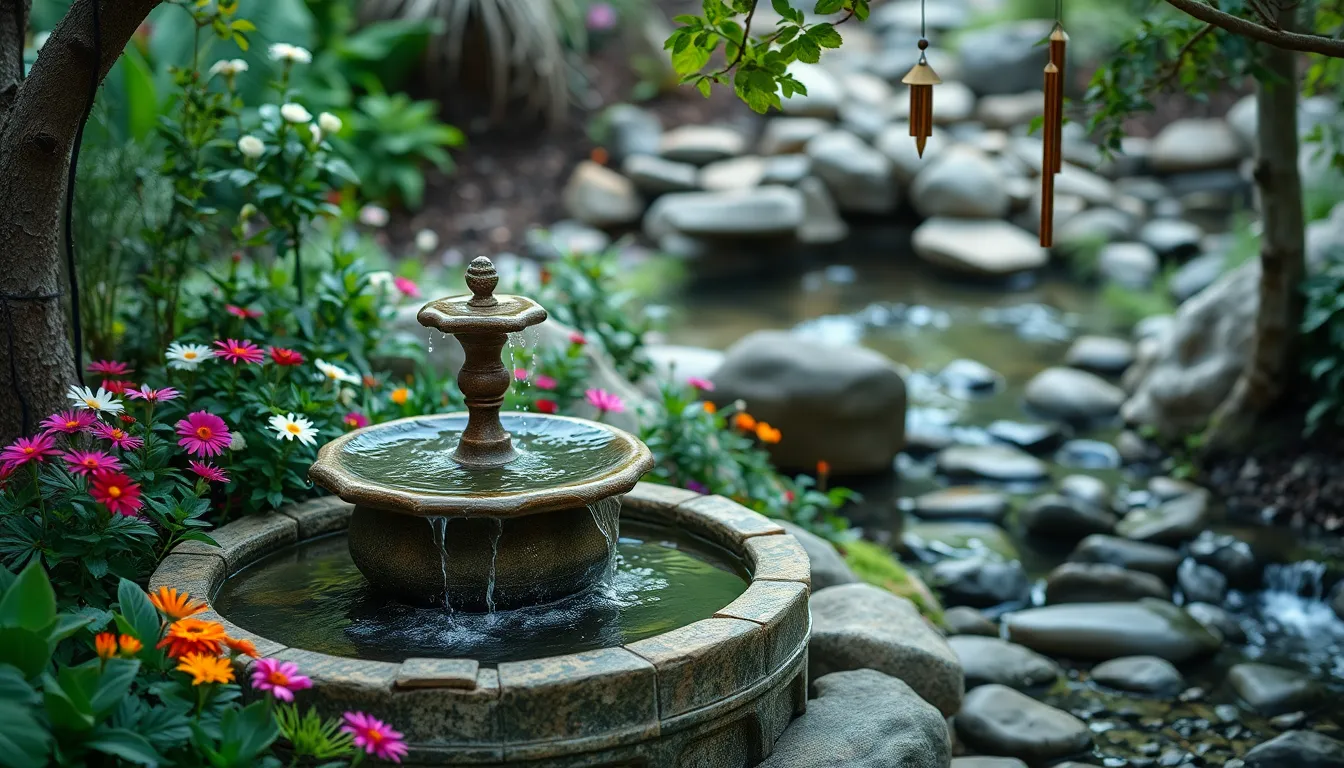
Moving beyond touch and texture, we can enhance our sensory garden with auditory elements that create a peaceful atmosphere through water’s natural sounds.
Add a Small Fountain or Bubbling Rock
Small fountains transform any sensory garden into a tranquil retreat with their gentle, continuous sounds. We recommend placing compact water features near seating areas where visitors can fully appreciate the soothing bubbling effects. Bubbling rocks offer a more natural appearance while providing the same calming audio experience that masks unwanted noise from traffic or neighbors.
Solar-powered options eliminate the need for electrical connections, making installation simpler in remote garden areas. Recirculating pumps keep maintenance minimal while ensuring consistent water flow throughout the day. We suggest positioning these features at varying heights to create layered sound effects that enhance the overall sensory experience.
Create a Gentle Stream or Rain Chain
Gentle streams provide constant, flowing sounds that naturally soothe the mind and create peaceful garden environments. We can install shallow water channels using flexible liners and smooth river stones to guide water movement along designated pathways. Rain chains offer an elegant alternative that transforms ordinary downspouts into musical water displays during rainfall.
Copper rain chains develop beautiful patinas over time while creating distinctive tinkling sounds as water cascades from link to link. Stream installations work particularly well when they connect different garden zones, encouraging visitors to follow the water’s path while discovering new sensory elements. We recommend incorporating gentle curves and small obstacles like stones to vary the water’s sound as it flows.
Include Wind Chimes for Musical Elements
Wind chimes add musical dimension to our sensory gardens through their melodic responses to natural air movement. We can select chimes made from bamboo, metal, or wood to create different tonal qualities that complement our garden’s overall atmosphere. Bamboo chimes produce softer, more organic sounds that blend naturally with rustling leaves and flowing water.
Strategic placement near pathways ensures visitors encounter these musical elements while exploring different garden areas. We suggest hanging multiple chimes at varying heights and locations to create layered soundscapes that change with wind direction and intensity. Metal chimes offer clearer, more resonant tones that carry further distances, making them ideal for larger garden spaces where sound needs to travel.
Plant Colorful Flowers for Visual Stimulation
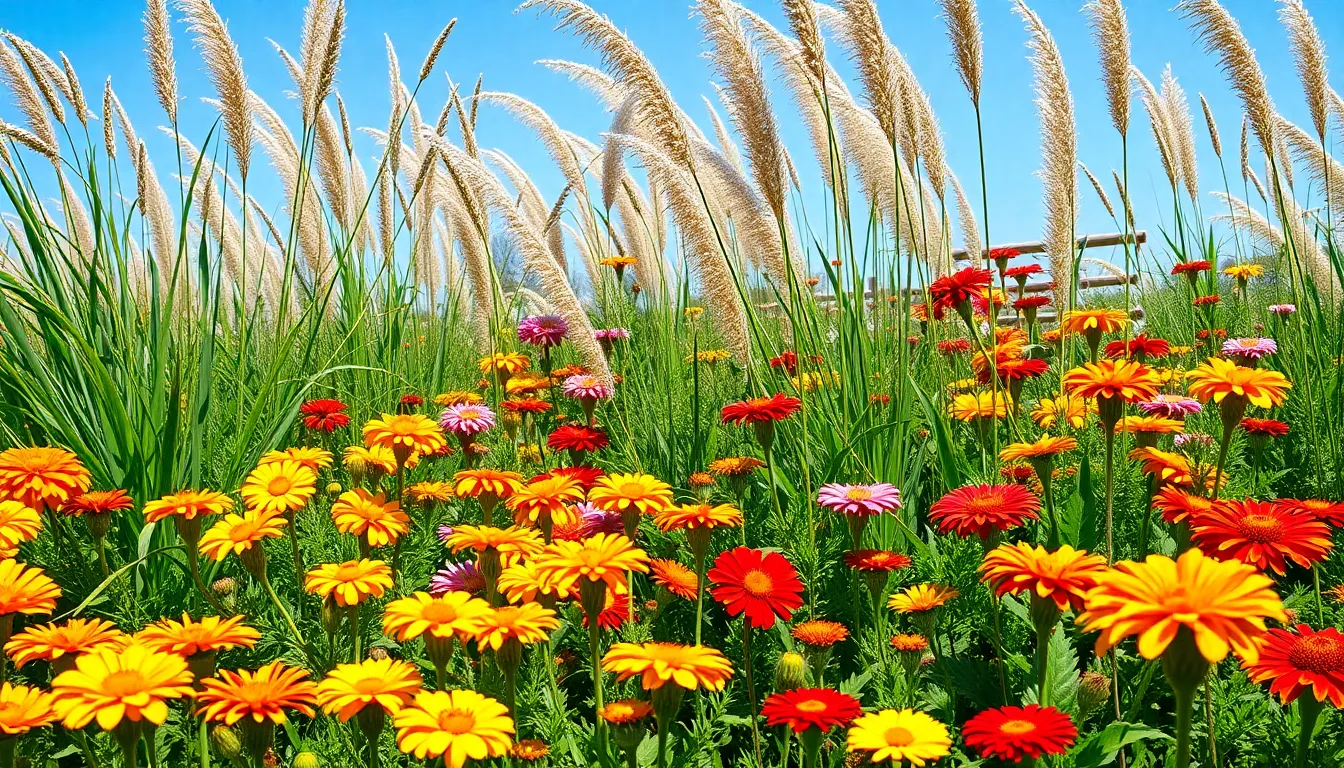
Creating stunning visual displays transforms sensory gardens into vibrant living canvases. We’ll explore strategic flower selection that provides continuous color throughout growing seasons.
Choose Bright Annuals Like Marigolds and Zinnias
Marigolds offer brilliant orange and yellow blooms that create instant visual impact in sensory gardens. These hardy annuals thrive in various soil conditions and provide consistent color from spring through fall. Zinnias complement marigolds perfectly with their diverse color palette ranging from deep reds to soft pastels.
We recommend planting marigolds along garden borders where their compact growth creates defined edges. Their pest-deterrent properties protect surrounding plants while maintaining vibrant displays. Zinnias work beautifully as backdrop plants due to their varying heights and full, rounded blooms.
These annual combinations require minimal maintenance while delivering maximum visual stimulation. Regular deadheading extends blooming periods and encourages continuous flower production throughout the growing season.
Select Perennials with Varying Bloom Times
Perennials with staggered bloom times create ever-changing visual experiences that change throughout the seasons. We suggest incorporating early bloomers like crocuses and daffodils for spring interest. Summer perennials such as coneflowers and black-eyed Susans maintain vibrant displays during peak growing months.
Strategic planning ensures continuous color progression from spring through fall. Late-season bloomers like asters and mums extend visual appeal into autumn months. This succession planting approach prevents visual gaps and maintains garden interest year-round.
Varying bloom times also support pollinators by providing consistent nectar sources. We recommend grouping perennials with similar growing requirements while staggering their flowering periods for optimal visual flow.
Add Ornamental Grasses for Movement
Ornamental grasses introduce graceful movement that enhances visual appeal in sensory gardens. These plants sway gently in breezes, creating ever-changing displays that contrast beautifully with static flower plantings. Fountain grass and feather reed grass provide excellent vertical elements.
We position ornamental grasses as backdrop plants or natural dividers between garden sections. Their flowing textures soften hard edges while adding architectural interest to sensory spaces. Seasonal changes in grass colors provide additional visual stimulation from green summer growth to golden autumn hues.
These grasses require minimal maintenance while delivering year-round visual interest. Their drought tolerance makes them practical choices for low-maintenance sensory garden designs that prioritize both beauty and sustainability.
Incorporate Edible Plants for Taste Experiences
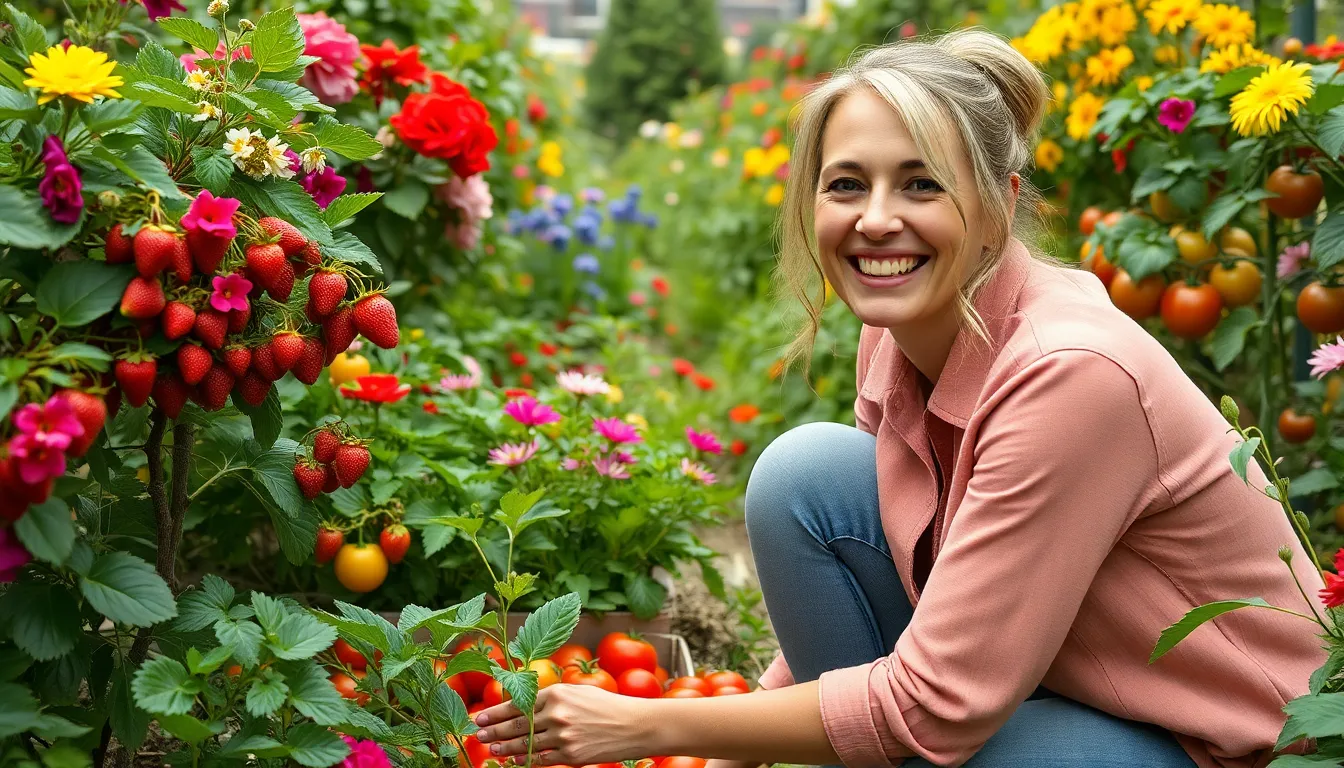
Creating a sensory garden that engages our sense of taste transforms the outdoor space into an interactive culinary adventure. Edible plants provide immediate satisfaction while adding layers of sensory stimulation beyond traditional decorative gardens.
Grow Berry Bushes and Fruit Trees
Alpine strawberries offer the perfect starting point for edible sensory gardens since they’re easy to grow and provide continuous harvests of small, flavorful strawberries throughout the growing season. We recommend planting these compact varieties along garden borders where visitors can easily sample the sweet fruit while exploring other sensory elements.
Fig trees serve dual purposes as both sensory focal points and productive fruit producers, creating dramatic visual appeal while attracting beneficial wildlife to the garden space. These trees thrive in sunny locations and provide delicious fruit that adds Mediterranean flavors to our sensory experience.
Blueberry bushes contribute year-round interest with spring flowers, summer fruit, and vibrant fall foliage that changes colors throughout the seasons. We suggest grouping different varieties together to extend the harvest period and create a dedicated berry-picking zone within the sensory garden.
Strawberry plants work exceptionally well in raised beds or containers where their trailing growth can cascade over edges, making the fruit easily accessible for tasting. This placement also allows us to control soil conditions and prevent the spread of runners into other garden areas.
Plant Vegetables with Different Flavors
Tomatoes provide diverse taste experiences ranging from sweet cherry varieties to tangy heirlooms, offering different textures and flavors that engage multiple taste receptors. We recommend selecting varieties with contrasting characteristics such as smooth-skinned cherry tomatoes alongside ribbed beefsteak types for maximum sensory impact.
Cucumbers add refreshing crunch and mild flavors that cool the palate between stronger taste experiences in the sensory garden. Their smooth skin and crisp texture create pleasant tactile sensations while their subtle taste cleanses the palate for other flavor sampling.
Peppers introduce varying levels of heat and sweetness, from mild bell peppers to spicy hot varieties that create memorable taste sensations. We suggest planting both sweet and hot options in separate areas to allow visitors to choose their preferred intensity level.
Sweet potatoes contribute earthy sweetness and dense textures that contrast with lighter vegetables, adding substance to the edible sensory experience. Their sprawling vines also provide ground cover and attractive foliage that enhances the visual appeal of vegetable areas.
Carrots offer natural sweetness and satisfying crunch that appeals to visitors of all ages, especially when pulled fresh from the soil. We recommend planting colorful varieties including purple, orange, and yellow types to create visual interest alongside taste diversity.
Add Edible Flowers Like Nasturtiums
Nasturtiums deliver peppery flavors with vibrant orange and yellow blooms that serve as both garnishes and salad ingredients. These easy-to-grow flowers thrive in poor soil conditions and provide continuous blooms throughout the growing season, making them ideal for beginner gardeners.
Evening primrose flowers offer delicate, slightly sweet flavors that complement salads and desserts while attracting beneficial pollinators to the sensory garden space. We recommend harvesting these flowers in early evening when they’re fully opened and at peak flavor intensity.
Hibiscus blooms contribute tart, cranberry-like flavors and stunning tropical colors that create dramatic visual focal points in edible flower displays. Their large petals work well for making herbal teas or adding colorful garnishes to summer beverages and desserts.
Pansy flowers provide mild, lettuce-like flavors with charming “faces” that delight children and adults exploring the sensory garden. We suggest planting these cool-season flowers in spring and fall when temperatures support their best growth and flavor development.
Edible flower gardens work best when we group different varieties together to create dedicated tasting zones where visitors can sample various flavors safely. This organization also makes harvesting easier while ensuring that ornamental and edible flowers remain clearly separated for safety purposes.
Build Accessible Pathways and Seating Areas

Creating inclusive sensory gardens requires thoughtful design that welcomes visitors of all abilities. We prioritize accessibility features that ensure everyone can fully experience the multi-sensory elements we’ve carefully planned.
Install Raised Garden Beds for Easy Access
Raised garden beds transform our sensory gardens into inclusive spaces where everyone can participate in gardening activities without physical strain. We recommend constructing beds at heights between 24 to 36 inches, allowing wheelchair users and those with mobility challenges to comfortably reach plants without bending or squatting.
Materials like cedar or composite lumber work exceptionally well for these installations, providing durability while maintaining an attractive appearance. We position raised beds along accessible pathways to ensure seamless integration with our garden’s overall design.
These elevated planting areas also improve drainage and soil quality, making them ideal locations for our fragrant herbs and tactile plants. We often incorporate different bed heights to accommodate various users, creating a layered visual effect that enhances the garden’s aesthetic appeal.
Create Wide Paths for Wheelchair Navigation
Wide pathways serve as the foundation for our accessible sensory garden design, ensuring smooth navigation for all visitors. We construct paths at least 36 inches wide, though 48 inches provides even better accessibility for wheelchair users and those using mobility aids.
Surface materials matter significantly in pathway design. We choose firm, stable surfaces like packed gravel, concrete pavers, or rubberized materials that provide excellent traction without creating barriers for wheels or walking aids.
Gentle slopes replace stairs wherever possible, maintaining grades under 5% to meet accessibility standards. We also ensure pathways connect all major garden features, including our water features, seating areas, and raised planting beds.
Strategic curves in pathway design create visual interest while maintaining accessibility, guiding visitors naturally through our carefully planned sensory experiences.
Add Comfortable Benches at Strategic Points
Comfortable seating areas throughout our sensory gardens provide rest stops and contemplation spaces for extended enjoyment. We place benches every 100 to 150 feet along pathways, ensuring visitors never feel too far from a resting spot.
Bench design considerations include back support, armrests, and heights between 17 to 19 inches for optimal comfort and accessibility. We position seating near our most captivating sensory elements, such as fragrant herb gardens or soothing water features.
Materials like weather-resistant wood, recycled plastic, or powder-coated metal ensure longevity while maintaining comfort in various weather conditions. We also incorporate benches with different orientations, some facing garden views and others positioned for social interaction.
Shade considerations play a crucial role in bench placement, utilizing natural tree canopies or installing pergolas to provide comfortable seating during warmer months.
Add Night-Blooming Plants for Evening Enjoyment
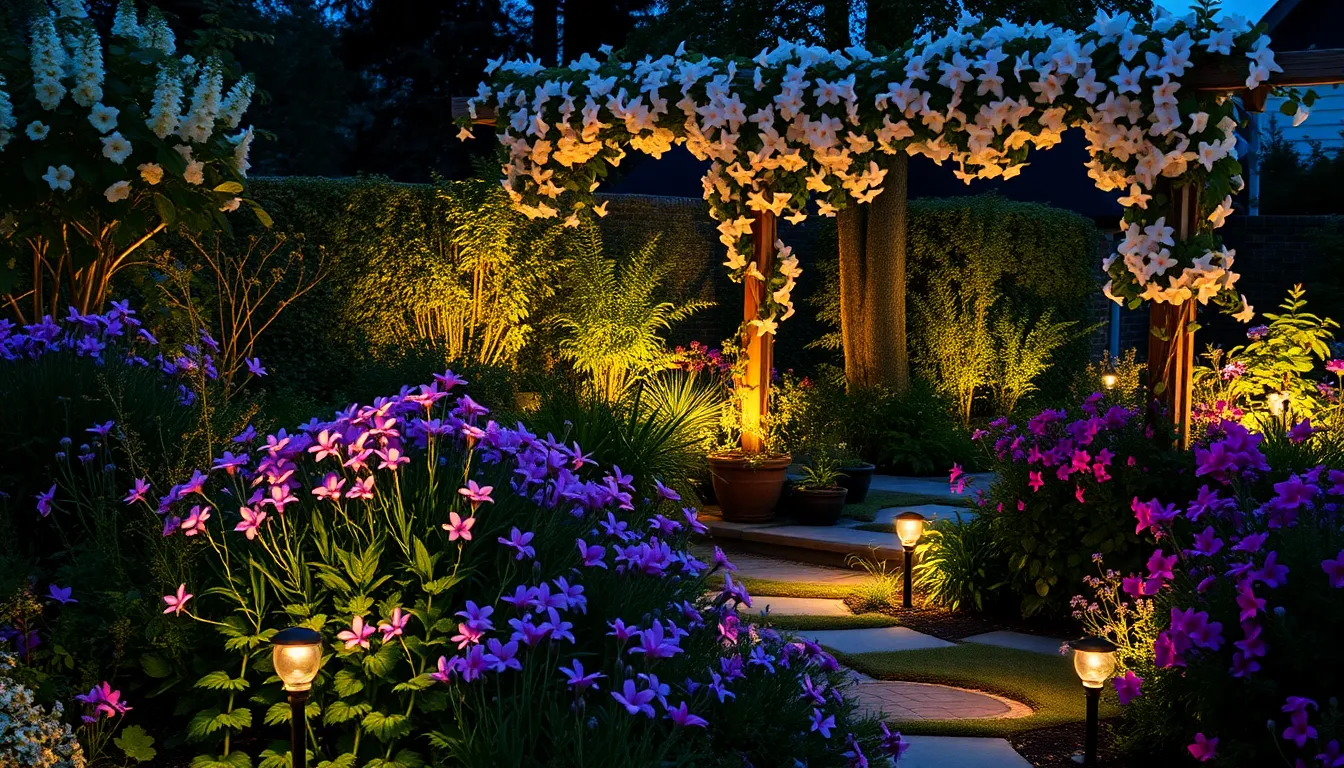
Extending your sensory garden experience into twilight hours creates magical moments when evening fragrances and nighttime blooms take center stage. We can transform our garden into an enchanting evening retreat by incorporating plants that specifically flourish after sunset.
Plant Evening Primrose and Four O’Clocks
Evening primrose delivers spectacular yellow blooms that unfurl as daylight fades, creating natural drama in your sensory garden industry. These hardy perennials thrive in well-drained soil and attract evening pollinators like moths, adding movement and life to your nighttime garden experience.
Four o’clocks complement evening primrose perfectly with their trumpet-shaped flowers that open precisely at 4 PM each day. We recommend planting these fragrant beauties along pathways where their sweet scent can be easily appreciated during evening strolls. Their vibrant colors range from white and yellow to deep magenta, providing visual interest throughout the growing season.
Both plants require minimal maintenance while delivering maximum sensory impact, making them ideal choices for busy gardeners seeking evening enjoyment.
Include Night-Blooming Jasmine for Fragrance
Night-blooming jasmine produces one of the most powerful and intoxicating fragrances in the plant kingdom, releasing its scent exclusively during evening hours. This climbing vine creates an aromatic backdrop that can be detected from considerable distances, making it perfect for anchoring your evening sensory experience.
Position jasmine near seating areas or bedroom windows where its incredible fragrance can be fully appreciated during relaxation time. The small white flowers may appear modest during daylight, but their evening perfume transforms your entire garden atmosphere after sunset.
We suggest training jasmine on trellises or pergolas to maximize scent distribution while creating vertical interest in your sensory garden design.
Add Solar Lighting for Safe Navigation
Solar lighting ensures safe movement through your evening sensory garden while highlighting your night-blooming plants for optimal visual appreciation. These energy-efficient fixtures charge during daylight hours and automatically illuminate pathways at dusk, requiring no electrical installation or ongoing energy costs.
Strategic placement of solar lights along garden paths prevents accidents while drawing attention to your carefully selected evening plants. We recommend using warm white LED solar lights that won’t interfere with the natural nighttime ambiance of your sensory space.
Path markers and spotlights specifically designed for garden use create layers of illumination that enhance both safety and beauty in your evening garden experience.
Create Seasonal Interest Throughout the Year
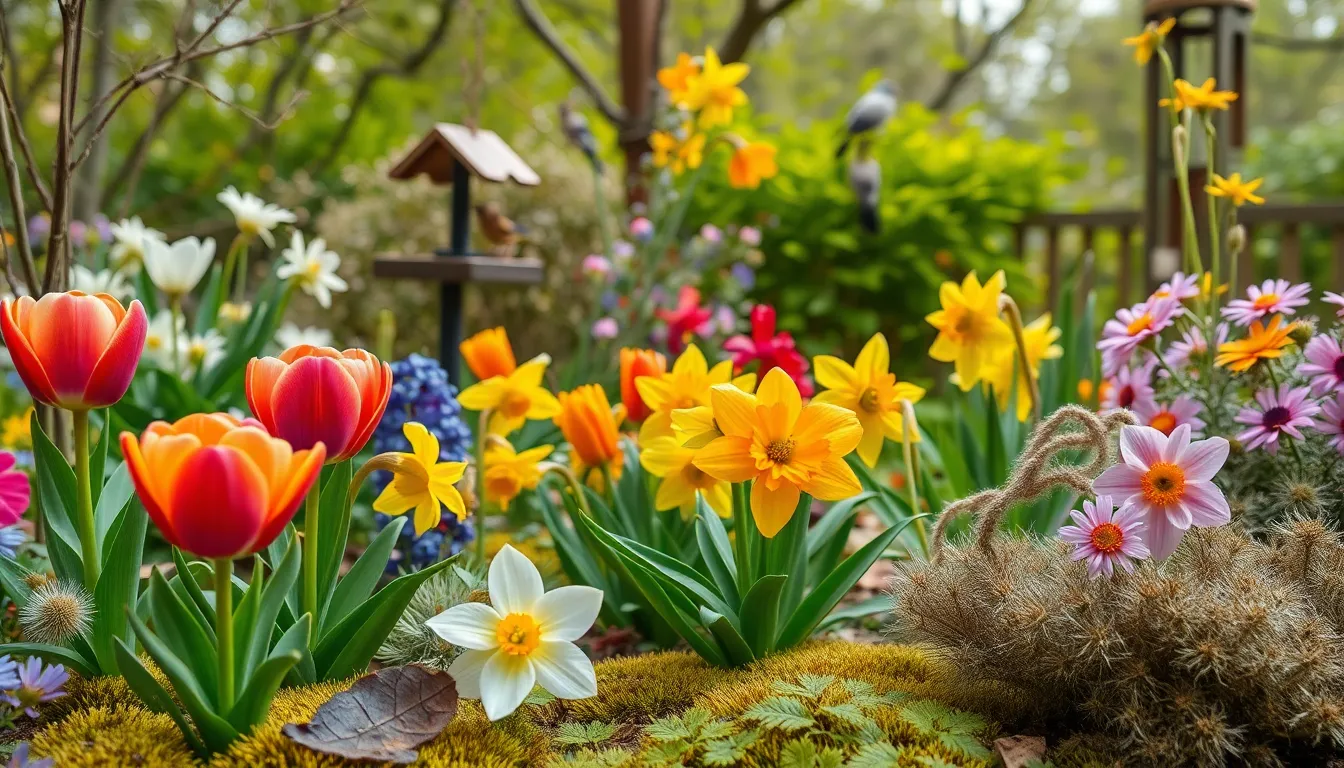
Designing a sensory garden that captivates visitors year round requires thoughtful planning across all four seasons. We’ll create an ever changing industry that engages our senses no matter when we visit.
Plan for Spring Bulbs and Early Bloomers
Spring awakens our sensory garden with vibrant colors and fresh fragrances from carefully selected bulbs and early flowering plants. We recommend planting tulips, daffodils, and hyacinths in fall for spectacular spring displays that offer both visual appeal and delightful scents. These bulbs create the foundation for our seasonal sensory experience, emerging when winter’s grip begins to loosen.
Soft textures invite touch during these early months, so we incorporate fuzzy leaves, delicate mosses, and velvety flower petals throughout spring planting areas. Early blooming flowers provide gentle tactile experiences that complement the visual awakening of our garden space.
Wildlife activity increases dramatically in spring, so we install bird feeders and plant nectar rich flowers to attract birds and early pollinators. This combination creates natural sounds and movement that enhance our garden’s auditory industry while supporting local ecosystems.
Include Summer Flowering Plants
Summer transforms our sensory garden into a bustling hub of color, fragrance, and wildlife activity through strategic plant selections. We plant sunflowers (Helianthus annuus), gayfeather (Liatris spicata), and butterfly weed (Asclepias tuberosa) to create magnificent displays that attract butterflies and bees throughout the growing season.
Sound and movement become central features during summer months, so we install wind chimes and add water features with trickling sounds to create soothing auditory experiences. Ornamental grasses sway gently in summer breezes, producing soft rustling sounds that complement our other sensory elements.
These summer flowering plants provide continuous blooms and fragrances that peak during the warmest months, ensuring our sensory garden remains vibrant and captivating when outdoor activities are most frequent.
Add Fall Foliage and Winter Structure Plants
Fall transitions bring dramatic visual changes through plants selected specifically for their autumn colors and textural qualities. We incorporate maples and oaks that display vibrant fall foliage, creating stunning visual interest as temperatures cool and daylight shortens.
Textural elements become more prominent during fall, so we include plants with rough bark, interesting seed pods, and leaves that create satisfying crunching sounds underfoot. These features add tactile and auditory dimensions that celebrate autumn’s unique sensory characteristics.
Winter structure relies on evergreen plants like conifers and holly to maintain visual interest and provide shelter for wildlife during cold months. We add aromatic evergreen plants and herbs that retain their scents throughout winter, ensuring our sensory garden continues to engage visitors even during dormant seasons.
Sound remains important during winter, so we maintain bird feeders to attract winter birds and position wind chimes strategically to provide gentle auditory interest when other garden sounds diminish.
Conclusion
We’ve explored how sensory gardens can transform any outdoor space into an captivating multi-sensory experience that appeals to all five senses. These thoughtful designs don’t require massive budgets or extensive expertise—just creativity and careful planning.
The beauty of sensory gardening lies in its adaptability. Whether you’re working with a sprawling backyard or a compact balcony every space offers opportunities to create meaningful sensory connections through plants textures sounds and interactive elements.
Remember that the most successful sensory gardens evolve over time. Start with a few key elements that resonate with you then gradually expand your sensory palette as your garden matures and your confidence grows.
Your sensory garden will become a personal sanctuary that nurtures both body and mind while creating lasting memories for everyone who experiences its unique magic.
Frequently Asked Questions
What is a sensory garden?
A sensory garden is a specially designed outdoor space that engages all five senses—sight, sound, smell, touch, and taste. These gardens create immersive experiences through strategic placement of aromatic herbs, textured plants, colorful flowers, water features, and edible plants. They can be created in various spaces, from large yards to small balconies, making them accessible to everyone.
Can I create a sensory garden in a small space?
Yes, sensory gardens are highly versatile and can be adapted to any space size. Small balconies, patios, or even windowsills can accommodate sensory elements. Use containers for herbs, add small water features, incorporate textured plants in pots, and choose compact varieties of flowers and edible plants to maximize your space’s sensory potential.
What are the best aromatic herbs for a sensory garden?
Lavender and rosemary are excellent choices for sunny, well-drained locations along pathways. Mint and basil provide invigorating scents and culinary value—plant them in containers to control growth. Scented geraniums offer unique fragrances that change throughout the day, creating a natural perfume library for visitors to explore and enjoy.
How do I create tactile experiences in my sensory garden?
Incorporate plants with varying textures like Lamb’s Ear (velvety leaves), fuzzy mullein, and rose petals for softness. Add contrasting elements such as smooth river rocks and rough tree bark. Install tactile sculptures and garden art made from natural materials to encourage hands-on exploration and create an interactive, engaging environment.
What water features work best for sensory gardens?
Small fountains and bubbling rocks create soothing sounds and work well near seating areas. Solar-powered options are easy to install, and varying heights create layered sound effects. Gentle streams or rain chains provide constant flowing sounds, while strategically placed features encourage exploration and create a harmonious, relaxing atmosphere throughout the garden.
How can I add visual interest to my sensory garden?
Plant bright annuals like marigolds and zinnias for continuous color. Choose perennials with staggered bloom times—crocuses and daffodils for spring, coneflowers and black-eyed Susans for summer. Include ornamental grasses for movement and architectural interest. This combination ensures year-round visual appeal while requiring minimal maintenance and providing constant sensory stimulation.
What edible plants should I include in a sensory garden?
Grow berry bushes like alpine strawberries and blueberries, plus fruit trees such as figs. Include vegetables with diverse flavors—tomatoes, cucumbers, peppers, and carrots. Add edible flowers like nasturtiums, hibiscus, and pansies for unique tastes and visual appeal. Organize these into dedicated tasting zones for safe sampling experiences.
How do I make my sensory garden accessible to everyone?
Create wide pathways (at least 36 inches) from firm materials for easy navigation. Install raised garden beds at 24-36 inch heights for wheelchair users and those with mobility challenges. Place comfortable benches strategically throughout the garden for rest areas. These design considerations ensure everyone can fully engage with the garden’s multi-sensory elements.
Can sensory gardens be enjoyed at night?
Yes, incorporate night-blooming plants like evening primrose, four o’clocks, and night-blooming jasmine for stunning fragrances after dark. Add solar lighting for safe navigation while highlighting evening plants. These elements create a magical nighttime retreat, allowing visitors to enjoy unique sensory experiences even after sunset.
How do I maintain seasonal interest in my sensory garden?
Plant spring bulbs like tulips and daffodils in fall for early color. Summer features should include sunflowers and butterfly weed. Select plants with vibrant autumn colors and interesting textures for fall appeal. Maintain winter structure with evergreens and aromatic herbs. This ensures your sensory garden remains captivating throughout the entire year.
